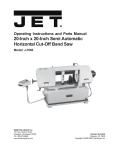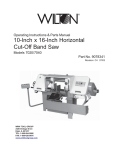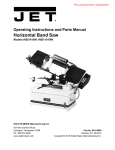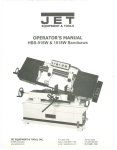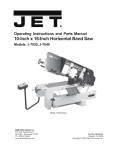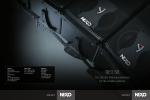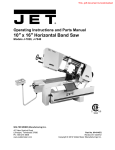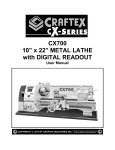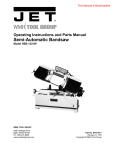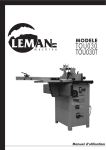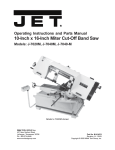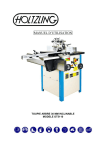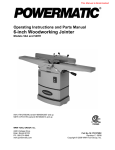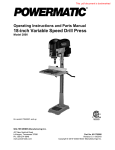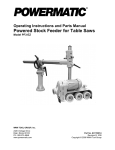Download Wilton 7060 User's Manual
Transcript
Operating Instructions — Parts Manual 20-Inch x 20-Inch Semi Automatic Horizontal Cut-Off Band Saw Model: 7060 WHM TOOL GROUP 2420 Vantage Drive Elgin, Illinois 60124 Ph.: 800-274-6848 www.wmhtoolgroup.com Part No. 5511736 Revision A2 08/06 Copyright © WMH Tool Group Table of Contents Cover Page ........................................................................................................................... 1 General Specifications .......................................................................................................... 4 Operating Precautions .......................................................................................................... 5 Operating Instructions ........................................................................................................... 7 Blade Selection/Break-in Procedures.................................................................................... 9 Work Set-up ....................................................................................................................... 10 Adjustments .........................................................................................................................11 Maintenance ....................................................................................................................... 14 Wiring Diagram ................................................................................................................... 19 Troubleshooting .................................................................................................................. 20 Replacement Parts ............................................................................................................. 22 3 General Specifications The Wilton 7060 Semi-Automatic Horizontal Cut-Off Band Saw incorporates a number of exclusive design features and innovations to make this saw a powerful and productive addition to machine shops, maintenance shops, tool rooms, and fabrication and welding shops. The exclusive swivel control panel allows the operator access to all machine controls from any side of the machine. The exclusive 6-point contact blade guide assemblies give the machine greater accuracy and longer blade life. The rapid acting, patented, 3jaw vise provides simple, fast, and accurate set-ups for both straight and miter cuts. In addition, the semiautomatic cycle enables the operator to initiate, with the push of a button, the following steps: blade start, saw head frame down, blade stop, and saw head frame up. This completely versatile band saw is a proven time saver, offering optimum sawing performance. Specifications 4 Cutting Capacity At 90 degrees At 45 degrees 12 inches Round/12 x 35 inches Rectangle 12 inches Round/12 x 12 inches Rectangle Blade Size Blade Wheel Diameter Blade Speeds 1 x 0.035 x 156 inches 17 inches Diameter, Cast Iron 82 to 262 SFPM, Variable Speed Motor 3 HP, 3 Phase, 230/460 Volts Dimensions 87 x 31.5 x 53 Inches Net Weight Shipping Weight 1,144 pounds 1,279 pounds - Misuse of this machine can cause serious injury. - For safety, machine must be set up, used and serviced properly. - Read, understand and follow instructions in the Operating Instructions and Parts Manual which was shipped with your machine. When Setting up Machine: - Always avoid using machine in damp or poorly lighted work areas. - Always be sure the machine support is securely anchored to the floor or the work bench. When Using Machine: - Always wear safety glasses with side shields (See ANSI Z87.1) - Never wear loose clothing or jewelry. - Never overreach - you may slip and fall. When Servicing Machine: - Always disconnect the machine from its electrical supply while servicing. - Always follow instructions in Operating Instructions and Parts Manual when changing accessory tools or parts. - Never modify the machine without consulting Wilton Corporation. You - the Stationary Power Tool User - Hold the Key to Safety. Read and follow these simple rules for best results and full benefits from your machine. Used properly, Wilton’s machinery is among the best in design and safety. However, any machine used improperly can be rendered inefficient and unsafe. It is absolutely mandatory that those who use our products be properly trained in how to use them correctly. They should read and understand the Operating Instructions and Parts Manual as well as all labels affixed to the machine. Failure in following all of these warnings can cause serious injuries. Machinery General Safety Warnings 1. Always wear protective eye wear when operating machinery. Eye wear shall be impact resistant, protective safety glasses with side shields which comply with ANSI Z87.1 specifications. Use of eye wear which does not comply with ANSI Z87.1specifications could result in severe injury from breakage of eye protection. 2. Wear proper apparel. No loose clothing or jewelry which can get caught in moving parts. Rubber soled footwear is recommended for best footing. 3. Do not overreach. Failure to maintain proper working position can cause you to fall into the machine or cause your clothing to get caught pulling you into the machine. 4. Keep guards in place and in proper working order. Do not operate the machine with guards re moved. 5. Avoid dangerous working environments. Do not use stationary machine tools in wet or damp locations. Keep work areas clean and well lit. 6. Avoid accidental starts by being sure the start switch is OFF before plugging in the machine. 7. Never leave the machine running while unattended. Machine shall be shut off whenever it is not in operation. 8. Disconnect electrical power before servicing. Whenever changing accessories or general maintenance is done on the machine, electrical power to the machine must be disconnected before work is done. 9. Maintain all machine tools with care. Follow all maintenance instructions for lubricating and the changing of accessories. No attempt shall be made to modify or have makeshift repairs done to the machine. This not only voids the warranty but also renders the machine unsafe. 10. Machinery must be anchored to the floor. 11. Secure work. Use clamps or a vise to hold work, when practical. It is safer than using your hands and it frees both hands to operate the machine. 12. Never brush away chips while the machine is in operation. 13. Keep work area clean. Cluttered areas invite accidents. 14. Remove adjusting keys and wrenches before turning machine on. 15. Use the right tool. Don’t force a tool or attachment to do a job it was not designed for. 16. Use only recommended accessories and follow manufacturers instructions pertaining to them. 17. Keep hands in sight and clear of all moving parts and cutting surfaces. 18. All visitors should be kept at a safe distance 5 from the work area. Make the workshop completely safe by using padlocks, master switches, or by removing starter keys. 19. Know the tool you are using — its application, limitations, and potential hazards. General Electrical Cautions This saw should be grounded in accordance with the National Electrical Code and local codes and ordinances. This work should be done by a qualified electrician. The saw should be grounded to protect the user from electrical shock. Wire Sizes Conductor Length 0 - 50 Feet 50 - 100 Feet Over 100 Feet Caution: For circuits which are far away from the electrical service box, the wire size must be increased in order to deliver ample voltage to the motor. To minimize power losses and to prevent motor overheating and burnout, the use of wire sizes for branch circuits or electrical extension cords according to the following table is recommended. AWG (American Wire Gauge) Number 240 Volt Lines 120 Volt Lines No. 14 No. 14 No. 14 No. 12 No. 12 No. 8 Safety Instructions on Sawing Systems 6 1. Always wear leather gloves when handling saw blade. The operator shall not wear gloves when operating the machine. 2. All doors shall be closed, all panels replaced, and other safety guards in place prior to the machine being started or operated. 3. Be sure that the blade is not in contact with the workpiece when the motor is started. The motor shall be started and you should allow the saw to come up to full speed before bringing the saw blade into contact with the workpiece. 4. Keep hands away from the blade area. See Figure A. 5. Remove any cut off piece carefully while keeping your hands free of the blade area. 6. Saw must be stopped and electrical supply must be cut off before any blade replacement or adjustment of blade support mechanism is done, or before any attempt is made to change the drive belts or before any periodic service or maintenance is performed on the saw. 7. Remove loose items and unnecessary workpieces from area before starting machine. A B 8. Bring adjustable saw guides and guards as close as possible to the workpiece. 9. Always wear protective eye wear when operating, servicing, or adjusting machinery. Eyewear shall be impact resistant, protective safety glasses with side shields complying with ANSI Z87.1 specifications. Use of eye wear which does not comply with ANSI Z87.1 specifications could result in severe injury from breakage of eye protection. See Figure B. 10. Nonslip footwear and safety shoes are recommended. See Figure C. 11. Wear ear protectors (plugs or muffs) during extended periods of operation. See Figure D. 12. The workpiece, or part being sawed, must be securely clamped before the saw blade enters the workpiece. 13. Remove cut off pieces carefully, keeping hands away from saw blade. 14. Saw must be stopped and electrical supply cut off or machine unplugged before reaching into cutting area. 15. Avoid contact with coolant, especially guarding your eyes. C D Introduction Operating Instructions This manual includes operating and maintenance instructions for the Wilton 12-inch by 20-inch Cut Off Band Saw, Model 7060. This manual also includes parts listings and illustrations of replaceable parts. Controls Cut-Off Saw Features Refer to Figure 1 and 2 for cut-off saw features Blade Guide Supports Blade Wheel Cover Blade Speed Control Control Panel The operating controls for the saw are provided in a control panel on the left side of the machine. The control panel is mounted on a pivoting tube. The pivoting tube allows the operator to position the control panel in a convenient location. Power-on Light Saw Head Up Saw Head Down 0 1 10 9 2 Start Switch 8 3 4 7 5 Coolant Sump Access Panel Stop Switch 6 0 Feed Rate Knob Blade Guides Saw Blade Coolant Overflow Coolant Temperature Base Figure 1: Saw Features (Front View) Hydraulic Cylinder Saw Head Blade Tension Handwheel Vise Handwheel Drive Motor Hydraulic Pump and Reservoir Electrical Panel Work Table Coolant Pump Access Panel Figure 2: Saw Features (Rear View) Capped Openings Emergency Stop (Non-functional) Coolant Pump Switch Figure 3: Control panel The upper row of controls include the following: 1. Power On light indicates when power is connected to the machine. 2. Saw Head Up pushbutton is used to raise the head. 3. Saw Head Down pushbutton is used to lower the head onto the workpiece. The center row of controls include the following: 1. Start pushbutton is used to start the saw blade drive motor and the hydraulic pump motor. The hydraulic pump provides the hydraulic pressure required to raise and lower the saw head. 2. Feed Rate control is used to set the rate at which the blade feeds through the workpiece. Variable Speed Adjustment From 25 MPM TO 75 MPM Recommended Speed for Cutting Various Materials SPEED/MPM 25 40 50 75 Material To Be Cut Tool Steel, Stainless Steel, Alloy Steel, Phosphor Bronze, Hard Bronze, Hard Cast Iron, Malleable Iron. Mild Steel, Soft Cast Iron, Medium Hard Brass, Medium Hard Bron Soft Brasses and Bronzes, Hard Aluminum, Plastics Plastics, Soft and Medium Soft Aluminum, Wood, Other Light Materials 7 The bottom row of controls include the following: 1. Stop pushbutton is used to stop the saw blade drive motor. 2. Emergency stop pushbutton is used to quickly disconnect electrical power to the machine. 3. Coolant On/Off selector switch is used to start and stop the coolant pump motor. Other Controls Refer to Figures 1 and 2 for location of the following controls: 1. Drive motor speed control: used to set drive motor speed in meters per minute. 2. Blade guide support adjustment: used to set distance between the saw blade guide bearing as required by the size of the workpiece. 3. Blade tensioning hand wheel: use to tighten the saw blade on the drive and idler wheels. 4. Vise clamping hand wheel: used to tighten the vise jaws against the workpiece. Setting Blade Speed 1. The blade speed is controlled by an adjustment mechanism on the right end of the saw. Speed increases when the adjustment knob is turned counterclockwise. Speed decreases when the knob is turned clockwise. 2. A placard on the drive belt guard (shown below) provides recommended speeds for various materials. 3. A speed indicator is provided on the barrel of the adjustment mechanism. The indicator provides speed indications in feet per minute and meters per minute. (The meters per minute values are shown in parenthesis on the indicator.) The graduations are: 8 WARNING: TO CHANGE SPEED, THE SAW MOTOR MUST BE OPERATING. 5. Turn the speed adjustment knob to the desired rate setting as determined by the material being cut. Raising/Lowering the Saw Head 1. To raise the saw head, press the Saw Head Up pushbutton. The saw head will raise until the upper limit switch (refer to Figure 4) trips. 2. To lower the saw head, press the Saw Head Down pushbutton. The saw head will lower until the lower limit switch trips. 3. When the saw head is being lowered to cut a workpiece, the saw blade drive motor must be started before lowering the blade against the workpiece. Set the coolant pump selector to the on ( I ) position If coolant is required by the material being cut. Upper Limit Switch (FT) 12 11 10 9 8 7 Lock Handle 6 5 4 3 2 1 Scale 0 Hydraulic Cylinder Lower Limit Switch Feet per Minute Meters per Minute 70 (21) 100 (30) 130 (40) 160 (48) Lower Limit Stop Figure 4: Limit Switches 4. The feed rates on the placard are expressed in meters per minute. The feed rate graduations available on the indicator may not match the recommended feed rate. An approximate speed may therefore be required. For example, to set a speed rate of 25 meters per minute, the indicator would be set about midway between 21 metersper-minute and the 30 meters-per-minute graduations. Controlling the Cut: Hydraulic Feed Control The weight of the saw arm provides all the force needed to move the saw blade through the workpiece. In fact, if the full weight of the arm is allowed to make the cut, rapid blade wear and poor cutting accuracy will result. A hydraulic feed control is provided on the control panel to provide the operator with a means to control the speed and efficiency of the cutting operation. The hydraulic cylinder is attached to the saw base and the saw head. Hydraulic pressure is provided to both sides of the hydraulic cylinder piston to raise and lower the saw head. The feed rate control on the control panel determines the rate at which the saw head is raised or lowered. The amount of downward force can be controlled by using the feed rate control valve. When the valve is opened slightly, the saw head will move downward. The further the valve is opened, the faster the saw head will move downward. The feed control is adjusted by the operator to maintain cutting efficiency. This is usually determined by observing the chip formation. (See Evaluating Blade Efficiency for more information on cutting efficiency.) Evaluating Cutting Efficiency Is the blade cutting efficiently? The best way to determine this is to observe the chips formed by the cutting blade. If the chip formation is powdery, then the feed rate is much too light, or the blade is dull. If the chips formed are curled, but colored — that is, either blue or straw-colored from heat generated during the cut — then the feed rate is too high. If the chips are slightly curled and are not colored by heat — the blade is sufficiently sharp and is cutting at its most efficient rate. Blade Selection The cut-off saw is provided with a saw blade that is adequate for a variety of cut-off jobs on a variety of common materials. A 4/6 vari tooth bi-metal blade (5512107) and a 6/10 vari tooth bi-metal blade (5512108) are available from Wilton. See Setting Blade Speed for the speeds recommended for various materials. These selections, while appropriate for many shop cutting needs, do not encompass the wide variety of blades of special configuration (tooth pitch and set) and special alloys for cutting unusual or exotic materials. A coarse blade could be used for a solid steel bar but a finer tooth blade would be used on a thin-wall tube. In general, the blade choice is determined by the thickness of the material; the thinner the material, the finer the tooth pitch. A minimum of three teeth should be on the work piece at all times for proper cutting. The blade and workpiece can be damaged if the teeth are so far apart that they straddle the workpiece. For very high production on cutting of special materials, or to cut hard-to-cut materials such as stainless steel, tool steel, or titanium, you can ask your industrial distributor for more specific blade recommendations. Also, the supplier who provides the workpiece material should be prepared to provide you with very specific instructions regarding the best blade (and coolant or cutting fluid, if needed) for the material and shape supplied. Blade Break-in Procedures New blades are very sharp and, therefore, have a tooth geometry which is easily damaged if a careful break-in procedure is not followed. Consult the blade manufacturer’s literature for break-in of specific blades on specific materials. However, the following procedure will be adequate for break-in of Wiltonsupplied blades on lower alloy ferrous materials. 1. Clamp a round section workpiece in the vise. The workpiece should be 2 inches or larger in diameter. 2. Set the saw on low speed. Start the cut with a very light feed rate. 3. When the saw has completed 1/3 of the cut, increase the feed rate slightly and allow the saw to complete the cut. 4. Keep the same hydraulic cylinder setting and begin a second cut on the same or similar workpiece. 5. When the blade has completed about 1/3 of the cut, increase the feed rate. Watch the chip formation until cutting is at its most efficient rate and allow the saw to complete the cut (see Evaluating Blade Efficiency). The blade is now considered ready for regular service. 9 Set Workpiece Against Corner of Right Vise Jaw Angle Setting Block Work Set-up Securing the Workpiece for Square Cuts (see figure 5) 1. Raise the saw head. 2. Slide the left vise jaw far enough to the left to allow the workpiece to be placed in the vise. 3. Place the workpiece on the work table. If the workpiece is long, provide support at the other end. It may also be necessary to provide additional downward clamping to hold the workpiece securely on the work table. 4. Turn clamping hand wheel clockwise to clamp the workpiece in position against the fixed (right) vise jaw. 5. After completing the cut, turn the clamping hand wheel counterclockwise and slide the left jaw away from the workpiece. Left Vise Jaw Pivot Screw Angle Locking Screw Figure 6: Adjusting vise Angle Block Locking Handle Angle Pointer Clamping Hand Wheel Left Vise Jaw Saw Head Work Table Figure 7: Angle setting block Installation and Adjustment of Work Stop The work stop is used to set up the saw for making multiple cuts of the same length (see figure 8). Install and adjust the work stop as follows: Figure 5: Securing workpiece Stop Post Adjusting the Vise for Angle Cuts (see figure 6) 10 1. Loosen the angle locking screw and the pivot screw on the left vise jaw. 2. Turn the locking handle on the round, anglesetting block counterclockwise to unlock the block. Slide the block until the pointer on the block is aligned with desired angle (see figure 7). Tighten the locking handle to set the angle. 3. Set the workpiece in the vise. Put the front end of the workpiece against the corner of the right vise jaw. Put the rear end of the workpiece against the angle-setting block. 4. Turn clamping hand wheel clockwise until the left vise jaw is parallel with the workpiece. Tighten the pivot screw and angle locking screw on the left vise jaw. Clamp the workpiece in position. 5. After completing the cut, turn the clamping hand wheel counterclockwise and slide the left jaw away from the workpiece. Locking Lever "Wing" Screw Stop L-Bracket Knob Stop Rod Figure 8: Work stop 1. Insert the end of the stop rod in the hole in the front right side of the work table. 2. Tighten the “wing” screw to secure the rod in place. 3. Install the stop post in the channel on the back of the stop L-bracket. Install the locking lever in the threaded hole in the stop post. Snug-up the locking lever. 4. Install the locking knob in the hole in the side of the stop L-bracket. 5. Slide the assembled stop L-bracket onto the stop rod. Position the stop post against the work piece and tighten the knob in the stop L-bracket. The stop post can be moved left or right as required to place the stop post against the work piece. Starting the Saw WARNING: NEVER OPERATE THE SAW WITHOUT BLADE COVERS IN PLACE AND SECURED. CAUTION: MAKE SURE THE BLADE IS NOT IN CONTACT WITH THE WORKPIECE WHEN THE MOTOR IS STARTED. DO NOT DROP THE SAW HEAD ON THE WORKPIECE OR FORCE THE SAW BLADE THROUGH THE WORKPIECE. 1. Raise the saw head. 2. Clamp the workpiece in the vise. (See figure 9 for examples of workpieces in the vise.) 3. Be sure to start the saw blade drive motor before allowing the blade to contact the workpiece. 4. Start the motor and allow the saw to come up to speed. 5. Slowly bring the saw down onto the workpiece. Adjust feed rate using feed rate control. 6. DO NOT LOWER THE SAW HEAD AT A RATE FASTER THAN THE SAW’S CAPABILITY OR FORCE THE CUT. Adjust the feed rate so the hydraulic cylinder provides the proper amount of downward force. 7. The saw will automatically shut off at the end of the cut. Rounds Coolant Flow CAUTION: THE COOLANT PUMP MUST BE SUBMERGED BEFORE OPERATING TO PREVENT DAMAGE TO THE PUMP. 1. The blade guides are fitted with coolant fittings. Coolant is provided to the fittings through interconnecting tubing. The coolant is dispensed directly onto the saw blade. 2. Adjust the coolant flow valves on the top, rear of the saw head as required to provide the desired flow. The flow should be no more than the blade can draw into the workpiece by movement of the blade. 3. The coolant flow can be stopped in two ways: 1) By using the coolant pump switch on the electrical equipment box, or 2) By closing the coolant flow valves on the top, rear of the saw head. Coolant Mixture and Quantity The general purpose coolant is a mixture of water soluble oil and water. Mix one part of soluble oil (TRIM SOL) to ten parts of water (one quart oil, ten quarts of water). The eleven quarts of coolant is the amount required for the coolant pump to operate properly. There are numerous coolants on the market that are formulated for special applications. Consult your local distributor for details in the event you have a long range production task, or are required to cut some of the more exotic materials. Adjustments Flats/strips Channels Knock off f sharp fedge here with f file Angles I-Beams The efficient operation of the cut-off saw is dependent upon the condition of the saw blade. If the performance of the saw begins to deteriorate, the first item that you should check is the blade. If a new blade does not restore the machine’s cutting accuracy and quality, refer to the Troubleshooting section (or the blade manufacturer’s guide) for conditions to consider and adjustments that can be made to increase the life of the blade. To change the blade, refer to Changing Blades in the Maintenance section. To adjust the blade tracking, refer to the following procedures. Squares/rectangles f Knock off sharp edge f here with file Hexagonals Tees Figure 9: Placing workpieces in the vise Blade Tracking Adjustment Blade tracking has been tested at the factory. Adjustment is rarely required when the blade is used properly or if the blade is correctly welded. (See figure 10 for location of blade tracking adjustment 11 Blade Tracking Hex Adjustment Screws Single Adjustment Screw Center Locking Screws Figure 10: Blade tracking and tensioning screws.) Factory or Field Procedure 1. Raise the saw head enough to allow the saw motor to operate. 2. Loosen four knobs securing the blade cover. Lift the cover and swing it backward. 3. Remove the blade guard mounted on the left blade guide support. 4. Remove both blade guide bearing brackets. NOTE: Maintain proper tension at all times using the blade tensioning mechanism. 5. Loosen the center locking screws in all three hex adjustment screws on the blade tensioning mechanism (see figure 10). CAUTION: WHILE PERFORMING THE FOLLOWING, KEEP THE BLADE FROM RUBBING EXCESSIVELY ON THE SHOULDER OF THE WHEEL. EXCESSIVE RUBBING WILL DAMAGE THE WHEEL AND/OR THE BLADE. 12 6. Start the saw. Slowly turn the single hex adjustment screw at the rear of the tracking mechanism to tilt the idler wheel. Do not turn either of the other two adjustment screws. Turn the adjustment screw until the blade is touching the shoulder of the idler wheel. NOTE: Turning the screw inward causes the blade to move toward the shoulder of the wheel. Turning the screw outward causes the blade to move away from the shoulder. 7. Turn the single hex adjustment screw so the blade starts to move away from the shoulder of the wheel — then immediately turn the single hex adjustment screw in the other direction so the blade stops, then moves slowly toward the shoulder. WARNING: KEEP FINGERS CLEAR OF THE BLADE AND WHEEL TO AVOID INJURY. 8. Turn the single hex adjustment screw to stop the motion of the blade on the wheel as it gets closer to the wheel shoulder. Put a 6-inch length of paper between the blade and the wheel as shown in figure 11. The paper should not be cut as it passes between the wheel shoulder and the blade. 9. Turn the single hex adjustment screw a small amount. Repeat the insertion of the paper between the wheel shoulder and the blade until the paper is cut in two pieces. NOTE: You may have to repeat the check with the paper several times before the blade and the shoulder cuts the paper into two pieces. Do not hurry the adjustment. Patience and accuracy here will pay off with better, more accurate, quieter cutting and much longer machine and blade life. 10. When the paper is cut, turn the hex adjustment screw slightly in the counterclockwise direction. This assures that the blade is not touching the shoulder of the wheel. 11. Shut off the saw. 12. Hold the hex adjustment screws with a wrench and tighten the center locking screws. Make sure the hex adjustment screws do not move while tightening the center screws. 13. Install the two blade guide bearing brackets. Position the guides so the bearings just touch the blade. 14. Install the left blade guard. 15. Close the saw head cover. Tighten the four knobs. Motor "ON" Upper Wheel Rotating Put Strip Between Wheel and Blade Figure 11: Checking blade-to-wheel clearance using paper strips Blade Guide Bearing Adjustment Proper adjustment of the blade guide bearings is critical to efficient operation of the cut-off saw. The blade guide bearings are adjusted at the Factory. They should rarely require adjustment. When adjustment is required, adjust immediately. Failure to maintain proper blade adjustment may cause serious blade damage or inaccurate cuts. It is always better to try a new blade when cutting performance is poor. If performance remains poor after changing the blade, make the necessary adjustments. If a new blade does not correct the problem, check the blade guides for proper spacing. For most efficient operation and maximum accuracy, provide 0.001 inch clearance between the blade and the guide bearings. The bearings will still turn freely with this clearance. If the clearance is incorrect, the blade may track off the drive wheel. CAUTION: CHECK THE BLADE TO MAKE SURE THE WELDED SECTION IS THE SAME THICKNESS AS THE REST OF THE BLADE. IF THE BLADE IS THICKER AT THE WELD, THE GUIDE BEARINGS MAY BE DAMAGED. If required, adjust the guide bearings as follows: 1. Two blade guides are used in each set of blade guides. The inner blade guide is fixed; the outer blade guide is adjustable. The outer blade guide is adjusted using a knurled knob on the operator side of the blade guide assembly. 2. A guide bearing is provided on the innermost side of the saw blade. The guide bearing is mounted on an eccentric bushing. 3. Hold the bushing with a 3/4-inch wrench and loosen the center locking screw with an Allen wrench (see figure 12). 4. Position the bearing by turning the bushing. Set the clearance at approximately 0.001 inch. INCORRECT Outer Roller 5. Tighten the center locking screw with an Allen 5. 5. Tighten the center locking screw with an Allen wrench while holding the eccentric bushing in position with the 3/4-inch wrench. 6. When the adjustment is correct, the guide bearing should rotate freely with slight pressure of the finger (with the blade stopped). 7. Adjust blade-edge bearings so they just touch the back edge of the blade (see figure 19). Concentric Bushing Blade Guide Bearings Socket Cap Screw Eccentric Bushing Carbide Guides Knurled Knob Figure 13: Adjustment of Guide Bearing Test Cutting to Verify Adjustment Accuracy 1. Clamp in vise and mark top of barstock here 2. Cut off a slice of the bar stock 13 3. Rotate stock in vise so mark is at bottom 4. Cut off a new slice from the stock CORRECT Inner Roller 5. Measure here... New slice Locking Screw Figure 12: Blade-To-Blade Guide Orientation 6. ...measure here 7. Differences between measurements at edges of disc should be less than .003 inches per inch per side of stock diameter Figure 14: Cutting a Test Test cuts can be used to determine whether or not you have adjusted the blade accurately. Use 2-inch round bar stock to perform these test cuts, as follows: 1. With the bar stock securely clamped in the vise, make a cut through the bar stock. (See figure 14.) 2. Mark the top of the bar stock. 3. Move the bar stock about 1/4-inch past the blade so you can begin a second cut. 4. Rotate the bar stock 180 degrees so the mark you made is now at the bottom of the cut. 5. Make a cut through the bar stock. 6. Use a micrometer to measure the thickness variation of the disk you have cut from the bar stock. Measure at the top and bottom of the disk. The saw blade can be considered correctly adjusted when the variation measure is no more than 0.012 inch across the face of the disk. Note: If you do not have a piece of 2-inch bar stock available for a test cut, use a larger diameter test piece rather than a smaller one. Maximum thickness variation on any test piece should be no more than 0.003 inch, per side, per inch of stock diameter. Adjustment of Limit Switches Adjustment of Lower Limit Switch 1. The lower limit switch is provided to shut off the saw blade drive motor when the workpiece is cut through. The switch causes the saw head to raise to its uppermost stop. 2. To set the limit switch, loosen the jam nut on the limit switch stop (figure15). 3. Adjust the stop as required and retighten jam nut. Adjustment of Upper Limit Switch 14 1. The upper limit switch is provided to stop the saw head when it reaches its uppermost stop. 2. To set the upper limit switch, loosen the clamping knob on the limit switch support bracket. Move the limit switch to the desired switch trip point (use the scale on the side of the support bracket). Lower Limit Switch Switch Follower Lower Limit Stop Jam Nut Figure 15: Lower Limit Switch Stop Adjustment Maintenance Cleaning 1. Clean off any preservative on machine surfaces. 2. After cleaning, coat the machined surfaces of the cut-off saw with a medium consistency machine oil. Repeat the oil coating process at least every six months. 3. Clean up accumulated saw cuttings after use. Make sure the lead screw is kept free of saw cuttings and other material that would cause damage. 4. Clean the chip sludge from the coolant tank. The frequency should be determined by how often the saw is used. Lubrication Lubricate the following components at the specified frequencies and using the lubricants defined below: 1. Ball bearings: the bearings are lubricated and sealed—periodic lubrication is not required. 2. Blade guide bearing: the bearings are lubricated and sealed—lubrication is not required. Inspect periodically. 3. Idler wheel bushing: the bearings are lubricated and sealed—lubrication is not required. Inspect periodically. 4. Lead screw bearing housing: lubricate monthly (see exploded figure, page 20). 5. Lead screw: lubricate with light oil monthly (see exploded figure, page 20). 6. Hydraulic cylinder pivot: lubricate with light oil every 6 months (see exploded figure, page 20). 7. Blade tension screw: lubricate with grease every 6 months (see exploded figure, page 24). 8. Blade brush bearing: lubricate with light oil monthly (see exploded figure, page 24). 9. Gear box: check oil once a year. 10. Change coolant on a frequency appropriate to the type of coolant being used. Oil based coolants can sour. Refer to the coolant supplier’s instructions for change frequency. 11. Coolant tank: clean every 6 months or as required. 12. Hydraulic oil reservoir: check oil level in oil reservoir by periodically checking the oil level indicator on the side of the reservoir. If oil level is low, service reservoir (refer to Servicing Hydraulic Oil). Servicing Hydraulic Oil WARNING: SHUT OFF ALL ELECTRICAL POWER TO THE MACHINE 1. Remove hydraulic oil reservoir access panel. 2. Check oil level (refer to Figure 16). If level is below the yellow (upper) line, the reservoir should be filled. 3. Disconnect electrical power. 4. Remove reservoir fill cap. 5. Add oil until the level is at the yellow (upper) line. Install reservoir fill cap. 6. If a significant amount of oil needed to be added, check for oil leaks in pump components, lines, and hydraulic cylinder. Correct source of leakage before operating the cut off saw. 7. Connect electrical power. Raise and lower the saw head to confirm that the saw is operating correctly. Motor FROM THE SAW TEETH. 3. Turn the blade tensioning hand wheel clockwise to relieve tension on the blade. Loosen the blade enough to remove the blade from the idler and drive wheels. Remove the blade from between the blade guides. 4. Install the new blade between the blade guide bearings and the carbide blade guides. Install the blade over the drive and idler wheels. 5. Turn the blade tensioning hand wheel counterclockwise to tighten the blade. Tighten the blade until the blade tension indicator reads TBD. 6. Operate the saw at low speed and observe the tracking of the blade. If tracking needs to be adjusted, refer to Blade Tracking Adjustment. 7. Adjust the bearings on the upper edge of the blade until they just contact the blade (see figure 19). 8. Check the guide bearings and the carbide guides to make sure they are just contacting the sides of the blade. 9. Install the left blade guard making sure there is ample clearance with the blade. 10. Make a test cut to make sure the blade tracks properly during operation. Adjust tracking as required (see Blade Tracking Adjustment). Pump Oil Fill Cap Reservoir Full Line (Amber) Fill Line (Red, Oil Low) Figure 16: Checking Hydraulic Oil Level Changing Blades WARNING: SHUT OFF ALL ELECTRICAL POWER TO THE MACHINE. 1. Loosen four knobs securing the blade cover. Lift the cover and swing it backward. 2. Remove the blade guard mounted to the left blade guide support. WARNING: ALWAYS WEAR LEATHER GLOVES WHEN HANDLING SAW BLADE TO AVOID INJURY Changing the Drive Belt 1. Disconnect the electrical power source from the cut-off saw to prevent any possibility of accidental motor start-up. 2. Set the arm at the full horizontal position. 3. Remove the knob on the drive belt cover. Remove the drive belt cover to expose the V-belt and pulleys. 4. Remove two screws, nuts, and washers from back of saw head support. Push on the motor support bracket to pivot the motor upward to loosen the tension on the belt. 5. Remove the worn belt. 6. Put the replacement belt in the pulleys. Allow the motor to pivot downward. 7. Install the two screws, nuts, and washers in back of saw head support and through the motor support bracket. 8. Install the drive belt cover. Install and tighten the knob on the drive belt cover. Replacing the Drive Motor 1. Disconnect the motor from all electrical power. Unplug the motor if it is plugged into a socket. Shut off the power to the branch and remove the connection to the junction box if the motor is hard wired to the branch. 15 2. Remove the drive belt from the drive motor pulley (see Changing the Drive Belt). 3. Remove motor pulley. 4. Open the motor junction box and disconnect the power cord wires from their terminals. 5. Remove the nuts, washers and bolts that secure the motor to the mounting plate. 6. Installation of a new motor is a reversal of the above steps. Replacing the Drive Wheel 1. Remove the blade (see Changing Blades). 2. Remove the screw, spring washer, and washer from the speed reducer shaft. 3. Pull the wheel from the speed reducer shaft. Remove the drive key from the speed reducer shaft. 4. Inspection: Examine drive edge and shoulder of the wheel for damage. Replace the wheel if damaged. 5. Install the key in the keyway in the speed reducer shaft. Align the keyway in the wheel with the key in the speed reducer shaft. Reinstall the wheel on the speed reducer shaft. 6. Install the screw, spring washer and washer in the end of the speed reducer shaft. 7. Install the blade (see Changing Blades). Replacing Idler Wheel or Idler Bearing 16 1. Remove the saw blade (see Changing Blades). 2. Remove the screw, spring washer, and washer from the idler shaft. 3. Remove the idler wheel. Remove the bearing from the idler wheel. 4. Inspection: Examine the drive edge and shoulder of the idler wheel for damage. Replace the wheel if damaged. 5. Inspect bearings for damage and smooth operation, Replace if faulty. 6. Install the bearing in the idler wheel. Install the idler wheel on the idler shaft. 7. Install the screw, spring washer and washer in the idler shaft. 8. Install the blade (see Changing blades). Scale (Metric) Lock Handle Lock Handle Left Guide Support Right Guide Support Figure 17: Blade Guide Supports 1. Loosen the knob on the blade guide support and slide the guide left or right as required. Repeat for the other blade guide. 2. Set the blade guide supports as required to accommodate the width/diameter of the workpiece. The blade guides should be positioned so the guides do not contact the workpiece as the saw head moves downward through the workpiece. Blade Tracking Hex Adjustment Screws Single Adjustment Screw Center Locking Screws Figure 18: Blade Guide Features Replacement of Carbide Blade Guides (see figure 19) Coolant Line Adjusting the Blade Guides The cut-off saw has adjustable blade guide supports (see figure 17). The blade guide supports allow you to set the blade guides for varying widths of workpieces. To make accurate cuts and prolong blade life, the blade guide supports should be set to just clear the workpiece to be cut. Scale (Inches) Guide Support Chip Brush Blade Edge Bearing (2) Eccentric-Mounted Guide Bearing Adjusting Knob Blade Guides Figure 19: Carbide Blade Guide Replacement 1. Remove front blade guide by removing adjustment knob, spring, and shaft. 2. Remove the rear blade guide by removing its attachment screw 3. Install replacement blade guide in the rear guide location. Secure with attachment screw. 4. Install replacement blade guide in the front guide location. Install shaft into guide. Install spring and adjustment knob. 5. Adjust outermost blade guide using adjustment knob. Set the guide so it just contacts the side of the blade. Replacement of Guide Bearings (see figure 19) 1. Remove the cap screw from the blade guide bearing. Separate the bushing and cap screw from the bearing. Discard the bearing. NOTE: There is a light press fit between the bearing and the bushing. 2. Install bushing in replacement bearing. Install cap screw through bushing and into guide support. 3. Turn the eccentric bushing in the guide support until the bearing contacts the blade. Replacement of Blade Edge Bearings (see figure 20) 1. Remove the capscrew from the blade edge bearing being replaced and discard the bearing. 2. Insert the capscrew into the new bearing. 3. Adjust blade edge guide bearings so they just contact the edge of the blade. Adjustment Cap Screw Guide Support Floating Block 2. Remove the attaching screw, spring washer and washer. Remove and discard the brush (see figure 20). 3. Install replacement brush and secure with screw, spring washer and washer. 4. Close the blade cover and secure with four knobs. Wire Brush Screw and Washers Figure 21: Wire Brush Replacing the Coolant Pump WARNING: DISCONNECT ELECTRICAL POWER TO THE MACHINE BEFORE PERFORMING ANY MAINTENANCE. 1. Disconnect electrical power. 2. Remove four screws and the coolant sump cover from the machine base (refer to Figure 21). 3. Disconnect coolant pump wiring (refer to Wiring Data). 4. Remove coolant pump attaching screws. Remove the coolant pump. 5. Install replacement coolant pump and secure with attaching screws. 6. Connect electrical wiring to coolant pump (see Wiring Data). 7. Connect electrical power. Start the machine to check operation of the pump. 8. Install the coolant sump cover and secure with four screws. Cap Screw Access Panel Screws (4) Blade Edge Bearing Access Panel Coolant Pump Junction Box Figure 20: Blade Edge Bearing Replacement Pump Screws (2) Replacement of the Wire Brush 1. Loosen four knobs securing the blade cover. Lift the cover and swing it backward. Coolant Drain Figure 22: Replacement of Coolant Pump 17 Machine Setup The saw delivered to you has been adjusted at the factory. A number of test pieces have been cut using the saw to verify the accuracy of cutting. Therefore, the only setup operations required before releasing the saw for service are spotting the saw and establishing the electrical connections to the motor. Uncrating and Spotting Spot the saw where it makes the most sense for the operations you will probably be doing. If you are going to be doing cut-off work on very long pieces of stock, allow plenty of room for the stock, and the infeed and outfeed supports. Remove the saw from the shipping skid and discard any hold-down devices that were used to secure the saw to the skid. Electrical Observe the following when connecting to the power source. (The cut-off saw wiring diagrams are provided in Figures 21 and 22.) WARNING: WILTON RECOMMENDS THAT ANY WIRING INVOLVING HARD WIRING OF THE SAW TO A BRANCH, OR ANY CHANGE OF VOLTAGE SUPPLIED TO THE MOTOR BE PERFORMED BY A LICENSED ELECTRICIAN. 18 1. Make sure the saw is disconnected from the power source, or that the fuses have been removed or breakers tripped in the circuit in which the saw will be connected. Make sure you put a warning placard on the fuse or circuit breaker to prevent accidental electrical shock. 2. If you are installing the motor power cord into a receptacle, make sure to use the appropriate plug. 3. If you are using hard-wired connections to a junction box, connect the wires in the box, and close the box. 4. Install the fuses or reset the breaker. 5. The saw is now ready for service. Wiring Diagram 19 Troubleshooting Fault Probable cause Suggested remedy Excessive blade breakage 1. Material loose in vise. 2. Incorrect speed or feed. 1. Clamp work securely. 2. Check Machinist’s Handbook for speed/feed appropriate for the material being cut. 3. Check Machinist’s Handbook for recommended blade type. 4. Adjust blade tension to the point where the blade just does not slip on the wheel. 5. Start the motor before placing the saw on the workpiece. 3. Teeth too coarse for material. 4. Incorrect blade tension. 5. Saw blade is in contact with workpiece before the saw is started. 6. Blade rubs on the wheel flange. 7. Misaligned guides. 8. Cracking at weld. Premature blade dulling 1. 2. 3. 4. Blade teeth too coarse. Blade speed too high. Inadequate feed pressure. Hard spots in workpiece or scale on/in workpiece. 5. Work hardening of material (especially stainless steel). 6. Insufficient blade tension. 7. Operating saw without pressure on workpiece. 6. Adjust blade tracking. 7. Adjust guides. 8. Longer annealing cycle. 1. 2. 3. 4. Use a finer tooth blade. Try a lower blade speed. Decrease spring tension. Increase feed pressure (hard spots). Reduce speed, increase feed pressure (scale). 5. Increase feed pressure by reducing spring tension. 6. Increase tension to proper level. 7. Do not run blade at idle in/on material. Bad cuts (out-of-square) 1. Workpiece not square with blade. 1. Adjust vise so it is square with the blade. (Always clamp work tightly in vise.) 2. Decrease pressure. 2. Feed pressure too fast. 3. Adjust guide bearing clearance to 3. Guide bearings not adjusted 0.001 inch (0.002 inch maximum). properly. 4. Gradually increase blade tension. 4. Inadequate blade tension. 5. Move blade guide bar closer to 5. Span between the two blade work. guides too wide. 6. Replace blade. 6. Dull blade. 7. Check blade speed 7. Incorrect blade speed. (see Figure 3). 8. Tighten blade guide assembly. 8. Blade guide assembly is loose. 9. Tighten blade guide bearing 9. Blade guide bearing assembly assembly. loose. 10. Adjust blade tracking. 10. Blade track too far away from wheel flanges. 11. Replace worn bearing. 11. Guide bearing worn. Bad cuts (rough) 1. Blade speed too high for feed pressure. 2. Blade is too coarse. 20 1. Reduce blade speed and feed pressure. 2. Replace with finer blade. Troubleshooting (Continued) Blade is twisting 1. Blade is binding in the cut. 2. Blade tension too high. 1. Decrease feed pressure. 2. Decrease tension on blade Unusual wear on side/back of blade 1. Blade guides worn 2. Blade guide bearings not adjusted. 3. Blade guide bearing bracket is loose. 1. Replace blade guides. 2. Adjust blade guide bearings. 1. Blade tooth pitch too coarse for workpiece. 2. Feed too slow; feed too fast. 1. Use blade with finer tooth pitch. Teeth missing/ripped from blade 3. Workpiece vibrating. 4. Gullets loading up with chips. Motor running too hot 3. Tighten blade guide bearing bracket. 2. Increase feed pressure and/or blade speed. 3. Clamp workpiece securely. 4a. Use blade with a coarse tooth pitch—reduce feed pressure. 4b. Brush blade to remove chips. 1. Blade tension too high. 2. Drive belt tension too high. 3. Blade too coarse for workpiece (especially with tubular stock). 4. Blade too fine for workpiece (especially with heavier, soft material). 5. Speed reducer gears require lubrication. 1. Reduce tension on blade. 2. Reduce tension on drive belt. 3. Use blade with fine tooth pitch. No coolant flow 1. 2. 3. 4. 1. 2. 3. 4. Excessive speed reducer noise/ vibration 1. V-belt is too tight. Pump motor is burned out. Screen/filter on pump is clogged. Impeller is loose. Coolant level too low. 4. Use blade with coarse tooth pitch. 5. Check speed reducer. Replace pump. Clean screen/filter. Tighten impeller. Add coolant to reservoir. 1. Reset V-belt tension. 21 Replacement Parts This section provides exploded view illustrations that show the replacement parts for the Model 7060 12-Inch x 20-Inch Semi-Automatic Horizontal Cut-Off Band Saw. Also provided are parts listings that provide part number and description. The item numbers shown on the illustration relate to the item number in the facing parts listing. Order replacement parts from: WHM TOOL GROUP 2420 Vantage Drive Elgin, Illinois 60124 Ph.: 800-274-6848 Identify the replacement part by the part number shown in the parts listing. Be sure to include the model number and serial number of your machine when ordering replacement parts to assure that you will receive the correct part. 22 Exploded View – Saw Base - Model 7060 Semi-Automatic Cut-Off Band Saw 11 10 9 8 12 13 1 2 14 15 27 16 17 18 7 21 6 65 66 3 5 20 19 26 29 23 77 48 110 109 117 116 67 68 82 87 88 89 90 91 84 85 86 107 131 121 123 124 106 105 125 104 99 101 100 96 98 95 92 97 94 126 103 102 43 83 70 69 132 128 127 41 71 111 119 120 60 44 73 72 93 58 59 40 61 46 45 81 108 118 129 54 62 80 76 114 115 122 53 63 64 47 113 112 130 38 34 24 75 74 133 37 22 25 134 30 36 55 56 57 79 78 136 135 31 32 51 33 50 49 39 4 137 35 52 28 42 23 24 Parts List – Saw Base - Model 7060 Semi-Automatic Cut-Off Band Saw Ref No. 1 2 3 4 5 6 7 8 9 10 11 12 13 14 15 16 17 18 19 20 21 22 23 24 25 26 29 Part Number 5512120 5512121 5512122 5512123 5512124 5512125 5512126 5512127 5512128 5512129 5512130 5512131 5512121 5512128 5512173 5512131 5512121 5512128 5512174 5512132 5512133 5512134 5512135 5512136 5512137 5512138 5512139 30 27 28 31 32 33 34 5512140 5512141 5512142 5512143 5512144 5512145 5512146 35 36 37 38 39 40 41 42 5512147 5512148 5512149 5512150 5512151 5512152 5512153 5512154 Description Bolt, Hex Cap (M12X35) Washer, Lock (M12) Pin Rack Bracket, Slide Block, Rack Screw, Set (M6X10) Jaw, Vise (Left) Washer (M12) Washer, Lock (M12) Bolt, Locking (M12X35) Bolt, Hex Cap (M12X40) Washer, Lock (M12) Washer (M12) Jaw, Vise (Right) Bolt, Hex Cap (M12X40) Washer, Lock (M12) Washer (M12) Scale, Angle Block, Protractor Vise Handle, Locking Washer (1/2-inch) Screw (3/8 x 1-inch) Washer Seat, Protractor Stop Block, Protractor Screw, Hex Cap, Socket (M10X25) Washer (M10) Bolt, Hex Cap (M8X30) Nut (M8) Bracket, Adjusting Plate, Switch Mounting Switch Limit (5101) Screw, Hex Cap, Socket (M8X20) Pin, Cylinder Pin, Retaining Washer, Lock (M10) Bolt, Hex Cap (M10X30) Cover, Cylinder Pin (20MM) Shaft, Pivot Bearing, Needle (CB3020) Qty 1 1 2 1 1 1 1 1 1 1 1 2 1 1 1 2 1 1 1 1 1 1 3 3 1 1 1 1 1 1 1 1 1 4 1 1 4 4 1 1 1 1 Ref No. 43 44 45 46 47 48 49 50 51 Part Number 5512155 5512156 5512140 5512150 5512157 5512158 5512159 5512160 5512161 52 5512162 53 54 5512163 5512146 55 56 57 58 59 60 61 62 63 5512128 5512164 5512165 5512166 5512167 5512168 5512169 5512156 5512171 64 65 66 67 68 69 70 71 72 5512167 5512676 5512677 5512175 5512154 5512128 5512155 5512178 5512179 73 74 75 76 77 78 79 80 5512167 5512166 5512182 5512183 5512213 5512156 5512184 5512185 Description Bolt, Hex Cap (M8X25) Washer, Lock (M8) Washer (M10) Bolt, Hex Cap (M10X30) Spring Cylinder Assembly,Hydraulic Plate, Switch Stop Washer, Lock (M6) Screw, Hex Cap, Socket (M6X12) Plate, Hydraulic Mounting (Top) Switch Limit (5102) Screw, Hex Cap, Socket (M8X20) Washer (M12) Washer, Lock (M12) Bolt, Hex Cap (M8X50) Bolt, Hex Cap (M8X20) Washer (M8) Bracket, Pivot Bracket, Limit Switch Washer, Lock (M8) Bolt, Hex Cap, Socket (M8X20) Washer (M8) Hand Wheel Assembly Seat, Lead Screw Work Table Bearing, Needle (CB3020) Washer (M12) Bolt, Hex Cap (M8X25) Knob, Lock Bolt, Hex Cap, Socket (M8X25) Washer (M8) Bolt, Hex Cap (M8X20) Seat, Lead Screw Screw, Lead Washer (M8) Washer, Lock (M8) Bolt, Hex Cap (M8X30) Screw Qty 1 1 1 1 1 1 1 1 1 1 1 4 3 3 3 4 4 1 1 2 2 2 1 1 1 1 1 2 1 1 1 2 1 1 2 2 2 4 Ref No. 81 82 83 Part Number 5512186 5512187 5512188 84 85 86 87 88 89 90 91 92 93 5512189 5512190 5512191 5512126 5512192 5512164 5512128 5512194 5512195 5512188 94 95 96 97 98 99 100 101 102 103 104 105 106 107 5512197 5512198 5512199 5512200 5512201 5512140 5512202 5512203 5512204 5512205 5512206 5512207 5512208 5512188 108 109 110 111 112 113 114 115 116 117 118 119 5512210 5512211 5512212 5512675 5512214 5512215 5512216 5512217 5512218 5512219 5512220 5512221 Description Cover, Electrical Panel Valve, Solenoid Screw, Hex Cap, Socket (M6X8) Cover, Panel Pump Assembly, Hydraulic Motor Screw, Set (M6X10) Bolt, Hex Cap (M12X35) Washer, Lock (M12) Washer (M12) Seat, Hydraulic Cover, Panel Screw, Hex Cap, Socket (M6X8) Plug, Drain (3/8-In. PT) Nut, Hex (M12) Bolt, Hex Cap (12X70) Bolt, Hex Cap (M10X30) Gauge, Coolant Washer (M10) Nut (M10) Base Knob, Lock Bracket, Stop Handle, Lock Stop, Work Rod, Stop Bolt, Hex Socket Cap (M6X8) Cover, Panel Washer, Lock Screw, Pan Head (M6X16) Pump, Coolant (1-Hp/3Ph) Tube, Connecting Switch (Saw Head Up) Switch (Saw Head Down) Screw, Pan Head (M5X8) Panel, Control Control, Cutting Pressure Box, Control Handle Qty 1 1 4 1 1 1 1 2 2 2 1 1 4 1 4 4 2 1 2 2 1 1 1 1 1 1 4 1 2 2 1 1 1 1 8 1 1 1 1 Parts List – Saw Base - Model 7060 Semi-Automatic Cut-Off Band Saw, (Continued) Ref No. 120 121 122 123 124 125 126 127 128 129 130 131 132 133 134 135 136 137 138 139 140 142 141 143 144 145 Part Number 5512222 5512223 5512224 5512225 5512226 5512227 5512228 5512229 5512230 5512231 5512232 5512228 5512234 5512235 5512682 5512237 5512238 5512681 5512240 5512241 5512242 5512243 5512244 5512245 5512246 5512247 Description Screw, Pan Head (M6X15) Valve, Relief Plate, Cover Box, Stationary Screw (M8X16) Plate, Sole Screw (1/4X5/8 In.) Bushing, Stationary Box Collar Screw (M5X8) Rod, Control Screw (1/4X5/8 In.) Bushing, Control Box Switch, Coolant Emergency Stop Switch, Stop Switch, Start Light, Power Indicator Strip, Terminal Transformer (3Ph) Fuse 1A Fuse 2A Fuse 3A Relay Switch, Overload Contactor, Magnetic (3Ph) Qty 4 1 1 1 4 1 2 1 1 4 1 2 1 1 1 1 1 1 1 1 1 2 1 2 1 3 138 145 2A 3A 1A 139 143 142 140 141 144 Electrical Components 25 26 Exploded View – Saw Head - Model 7060 Semi-Automatic Cut-Off Band Saw 146 147 148 149 167 171 150 166 163 164 168 158 165 152 162 161 156 159 169 153 154 155 201 230 157 200 199 173 205 203 228 198 206 204 227 174 197 196 207 195 175 226 231 225 209 208 222 224 232 220 218 236 235 244 190 211 185 184 183 182 181 193 213 See Detail 'A' 248 259 246 249 258 251 252 257 256 255 247 253 254 178 192 214 239 240 241 243 212 177 191 215 238 245 194 217 216 237 219 210 221 176 186 223 260 234 170 202 229 160 233 172 151 239 Detail 'A' 180 179 Parts List – Saw Head - Model 7060 Semi-Automatic Cut-Off Band Saw Ref No. 146 147 148 149 150 151 152 153 154 155 156 Part Number 5512248 5512249 5512250 5512251 5512252 5512253 5512254 5512255 5512126 5512256 5512257 157 158 159 160 161 5512128 5512259 5512260 5512261 5512146 162 163 164 165 166 167 168 169 170 171 172 173 174 175 176 177 178 179 180 181 182 183 184 185 186 5512156 5512263 5512264 5512265 5512266 5512267 5512268 5512269 5512270 5512271 5512272 5512273 5512274 5512156 5512275 5512276 5512277 5512278 5512279 5512280 5512281 5512282 5512283 5512284 5512167 Description Bearing, Thrust (51194NJK) Indicator, Tension Washer, Flat Washer, Special Spring Bracket, Slide Washer, Lock Screw, Hex Cap Screw Assembly Screw, Set (M6X10) Nut, Hex (M16) Screw, Hex Cap, Socket (M12X25) Washer (M12) Bracket, Slide Gib Shaft, Blade Wheel Bracket Screw, Hex Cap, Socket (M8X20) Washer, Lock (M8) Shaft, Tension Bar, Extension Key (5X5X20) Wheel, Handle Screw, Set (M8X10) Head, Connection Clamp, Hose Gear Box Assembly Motor Key (8X8X40) Key (7X7X45) Seat, Support Bracket Washer, Lock (M8) Belt (1922V321) Bolt, Hex Cap (M8X16) Variable Speed Assembly Knob (3/8 In.) Washer Cover, Pulley Pulley, Gear Box Shaft Plate, Variable Speed Plate Washer (M8) Qty 1 1 1 18 1 3 3 3 1 1 1 1 1 2 1 6 6 1 1 1 1 1 1 5 1 1 1 1 1 3 1 3 1 1 1 1 1 1 1 2 3 Ref No. 190 191 192 193 194 195 196 197 198 199 200 201 202 203 204 205 206 207 208 209 210 211 212 213 214 Part Number 5512285 5512149 5512287 5512288 5512192 5512129 5512291 5512292 5512293 5512294 5512295 5512296 5512297 5512128 5512299 5512300 5512301 5512302 5512167 5512156 5512304 5512680 5512306 5512107 5512108 5512308 215 216 217 218 219 220 221 5512149 5512140 5512311 5512312 5512192 5512314 5512315 222 5512316 223 224 225 226 227 228 5512317 5512318 5512319 5512140 5512321 5512322 Description Box Assembly, Blade Wheel Washer, Lock (M10) Bolt, Hex Cap (M10X35) Hose (30MM) Bolt, Hex Cap (M12X35) Washer, Lock (M12) Nozzle, Flexible Guide, Blade Knob Bolt, Stand Nut, Hex (1/4 In.) Clamp, Hose Bracket, Blade (Left) Washer (M12) Bolt, Hex Cap (M12X30) Bolt, Hex Cap (M6X12) Washer, Lock (M6) Bracket, Blade (Right) Washer (M8) Washer, Lock (M8) Seat, Wire Brush Brush, Wire Washer (M6) Blade 4/6 TPI (Standard) Blade 6/10 TPI Screw, Hex Cap, Socket (M10X45) Washer, Lock (M10) Washer (M10) Washer Screw Bolt, Hex Cap (M12X35) Screw, Set (M8X10) Bracket, Adjustable Mount (Right) Bracket, Adjustable Mount (Left) Block, Lock Screw, Set (M8X16) Handle, Locking (3/8X2 In. Washer (M10) Scale, Angle Screw, Pan Head (M5X8) Qty 1 4 4 1 4 4 1 1 2 1 1 2 1 4 4 2 2 1 6 6 1 1 1 1 1 4 4 4 1 1 2 4 1 1 2 8 2 2 1 4 Ref No. 229 Part Number 5512323 230 231 232 233 234 235 236 237 5512324 5512325 5512326 5512327 5512328 5512329 5512330 5512331 238 239 5512332 5512333 240 241 242 242A 242B 242C 243 244 245 246 247 248 249 250 251 252 253 254 255 5512684 5512683 5512678 5512337 5513861 5517141 5512340 5512341 5512342 5512343 5512344 5512345 5512346 5517140 5512686 5512685 5512350 5512222 5512351 256 257 258 259 260 261 5512160 5512306 5512221 5512354 5512355 5517143 Description Screw, Hex Cap, Socket (M10X25) Bracket, Side Wheel, Idler Bearing, Ball (6206Z) Washer (M12X35W) Bolt, Hex Cap (M12X25) Guard, Blade Bracket, Guide (Left) Screw, Hex Cap, Socket (M8X30) Bearing, Ball Screw, Hex Cap, Socket (M6X16) Rear Blade Guide, Left Front Blade Guide, Left Assembly, Eccentric Shaft Screw, Cap (M8X40) Bearing, Ball (6201ZZ) Bushing, Eccentric Shaft Shaft Spring Knob, Adjusting Wheel, Drive Washer (M12 X50MM) Screw Bracket, Guide (Right) Bushing, Center Shaft Rear Blade Guide, Right Front Blade Guide, Right Cover, Blade Wheel (Right) Screw, Pan Head (M6X15) Screw, Hex Cap, Socket (M6X12) Washer, Lock (M6) Washer (M6) Handle Guard, Wire Brush Screw (1/4X3/8) Assembly, Center Shaft Qty 2 1 1 3 1 4 1 1 1 4 4 1 1 2 4 8 2 2 2 2 1 1 1 1 2 1 1 1 4 2 2 2 2 1 6 2 27 WHM TOOL GROUP 2420 Vantage Drive Elgin, Illinois 60124 Ph.: 800-274-6848




























